Cortical Nephron vs. Juxtamedullary Nephron — What's the Difference?
Edited by Tayyaba Rehman — By Fiza Rafique — Published on December 21, 2023
Cortical Nephron primarily resides in the renal cortex, with short loops, while Juxtamedullary Nephron has long loops extending into the medulla, aiding in water conservation.

Difference Between Cortical Nephron and Juxtamedullary Nephron
Table of Contents
ADVERTISEMENT
Key Differences
Cortical Nephron, as the name implies, is primarily located in the renal cortex of the kidney. Their structure is designed to process and filter blood primarily from this region. Conversely, Juxtamedullary Nephron not only originates near the medulla but has a significant portion of its loop descending deep into the medulla.
While the primary function of the Cortical Nephron is filtration and reabsorption, its relatively short loop of Henle isn't extensively involved in water reabsorption. On the other hand, the Juxtamedullary Nephron, with its long loop of Henle, plays a pivotal role in concentrating urine, helping in significant water reabsorption and thus, conserving water.
In terms of distribution, Cortical Nephron is more numerous, accounting for approximately 85% of the nephrons in the kidney. On the contrary, the Juxtamedullary Nephron, though fewer in number, has an essential role in establishing a concentration gradient in the medulla, facilitating the concentration of urine.
To sum up, while both Cortical Nephron and Juxtamedullary Nephron participate in the filtration and processing of blood, their locations, structural differences, and specific functions in urine formation and concentration differentiate them.
Comparison Chart
Location
Primarily in the renal cortex
Originates near the medulla, extends into medulla
ADVERTISEMENT
Loop of Henle Length
Short
Long
Primary Function
Filtration and reabsorption
Urine concentration and water conservation
Distribution in Kidney
More numerous (~85% of nephrons)
Fewer in number
Role in Concentration
Less involved
Key role in establishing concentration gradient
Compare with Definitions
Cortical Nephron
Most nephrons in the kidney are of the Cortical Nephron type.
The predominance of Cortical Nephron supports the kidney's primary filtration function.
Juxtamedullary Nephron
Juxtamedullary Nephron helps establish a concentration gradient in the medulla.
The osmotic gradient created by the Juxtamedullary Nephron aids in urine concentration.
Cortical Nephron
Cortical Nephron primarily functions in filtration and reabsorption.
The design of the Cortical Nephron is optimized for effective filtration.
Juxtamedullary Nephron
This nephron type plays a key role in urine concentration.
When water needs to be conserved, the Juxtamedullary Nephron's function becomes critical.
Cortical Nephron
Cortical Nephron is essential for processing blood from the renal cortex.
Blood filtered through the renal cortex is primarily handled by the Cortical Nephron.
Juxtamedullary Nephron
Juxtamedullary Nephron originates near the junction of the cortex and medulla.
The positioning of the Juxtamedullary Nephron facilitates its extended loop's dive into the medulla.
Cortical Nephron
Cortical Nephron has a shorter loop of Henle.
The short loop of the Cortical Nephron plays a limited role in water reabsorption.
Juxtamedullary Nephron
They are fewer in number compared to Cortical Nephron.
Though not as numerous, the Juxtamedullary Nephron has a distinct function in the kidney.
Cortical Nephron
Cortical Nephron is a kidney structure primarily located in the renal cortex.
The majority of nephrons in the kidney are Cortical Nephron.
Juxtamedullary Nephron
Juxtamedullary Nephron has a long loop extending deep into the kidney's medulla.
The design of the Juxtamedullary Nephron aids in the concentration of urine.
Common Curiosities
What is the key role of the Juxtamedullary Nephron?
Juxtamedullary Nephron plays a pivotal role in urine concentration and water conservation.
Why is the Juxtamedullary Nephron's loop of Henle significant?
Its long loop aids in establishing a concentration gradient in the medulla, crucial for urine concentration.
Which is more common, Cortical Nephron or Juxtamedullary Nephron?
Cortical Nephron is more common, making up about 85% of nephrons in the kidney.
Which type of nephron has a longer loop of Henle?
The Juxtamedullary Nephron has a longer loop of Henle.
How does the Cortical Nephron primarily function?
Cortical Nephron primarily functions in filtration and reabsorption.
Where is the Cortical Nephron primarily located?
Cortical Nephron is primarily located in the renal cortex of the kidney.
What percentage of nephrons are of the Cortical Nephron type?
Approximately 85% of nephrons in the kidney are Cortical Nephron.
Where does the Juxtamedullary Nephron originate?
The Juxtamedullary Nephron originates near the junction of the cortex and medulla.
What is the primary structural difference between the two nephron types?
The length of the loop of Henle differentiates Cortical Nephron (shorter) from Juxtamedullary Nephron (longer).
Are Cortical Nephron involved in establishing the medullary concentration gradient?
While they play a role, it's the Juxtamedullary Nephron that is primarily responsible for this gradient.
Are Juxtamedullary Nephron vital for water conservation?
Yes, Juxtamedullary Nephron are essential for conserving water in the body.
How are Cortical Nephron and Juxtamedullary Nephron involved in urine formation?
Both participate in filtration and processing of blood, but Juxtamedullary Nephron plays a larger role in urine concentration.
Why is the Cortical Nephron's location significant?
Its location in the renal cortex allows it to effectively handle blood filtration from this region.
Which nephron type is more involved in water reabsorption?
The Juxtamedullary Nephron, with its longer loop, is more involved in water reabsorption.
How does the Juxtamedullary Nephron contribute to the kidney's function?
It helps establish a concentration gradient in the medulla, which is pivotal for the concentration of urine.
Share Your Discovery

Previous Comparison
Were vs. Have Been
Next Comparison
Hexane vs. n-HexaneAuthor Spotlight
Written by
Fiza RafiqueFiza Rafique is a skilled content writer at AskDifference.com, where she meticulously refines and enhances written pieces. Drawing from her vast editorial expertise, Fiza ensures clarity, accuracy, and precision in every article. Passionate about language, she continually seeks to elevate the quality of content for readers worldwide.
Edited by
Tayyaba RehmanTayyaba Rehman is a distinguished writer, currently serving as a primary contributor to askdifference.com. As a researcher in semantics and etymology, Tayyaba's passion for the complexity of languages and their distinctions has found a perfect home on the platform. Tayyaba delves into the intricacies of language, distinguishing between commonly confused words and phrases, thereby providing clarity for readers worldwide.
















































